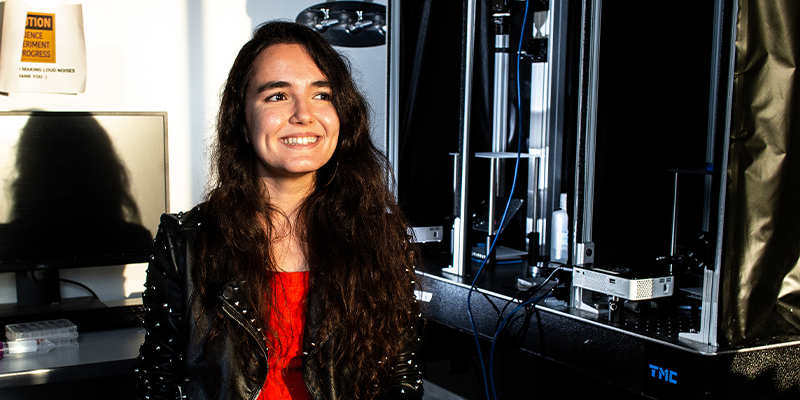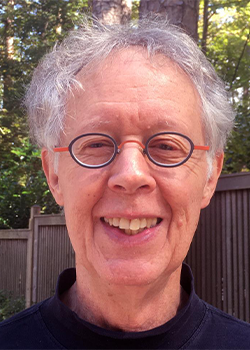
Duke Researchers Probe the Magic of Psychedelics as Medicine
Decades after most hallucinogens were outlawed in the 1970s, scientists are researching their use in treating disorders like post-traumatic stress disorder, depression, and addiction. How they work is still a mystery.
Across the Duke University School of Medicine, researchers are starting to understand their magic.
When people use psychedelics, several processes are believed to be at play in the brain. The substances can change how certain mood-related chemicals including serotonin receptors work, potentially reduce inflammation, and increase communication between specific emotional and sensory processing networks.
These mechanisms might help explain the profound and sometimes healing effects of psychedelics MDMA, psilocybin – the primary compound in magic mushrooms -- lysergic acid diethylamide (LSD) and ketamine, all known for their hallucinogenic properties.
Minel Arinel, a graduate student in the Department of Neurobiology, is stepping into the psychedelic research renaissance by using hallucinogenic fish to learn how these drugs function in the brain.
“Clinical trials just ask whether people with psychiatric disorders get better,” Arinel said. “There's not much of a mechanistic understanding of what exactly is happening when you're on psychedelics.”
To answer those questions, Arinel and her team turn to a tiny animal model: larval zebrafish which are the size of an eyelash.

After dosing them with DOI, a drug similar to LSD but much easier to legally obtain (if you’re a scientist), Minel and her undergraduate research assistants watch how zebrafish move about and perceive their world differently while on the psychedelic.
“It really changes their sensitivity to the dark,” Arinel said. “At lower concentrations of DOI, they move way more in the dark, but as the concentration increases, they start moving less and less. They kind of just float around in the water and lose motor control.”
Now that some of the behavioral effects are known, Arinel’s current project with undergraduates is to see how brain cells (and which ones) are changing to impact a fish’s movement and perception while on DOI.
While the brain data are still being collected, Arinel emphasizes that even once they are analyzed, her research on DOI won’t lead to cures for neurological disorders any time soon.
“We cannot say, ‘We gave this drug to a fish, so we're going to cure PTSD,’ or anything like that,” Arinel said.
The Promise of Psychedelics
While Arinel explores the underpinnings of hallucinogens, graduate students Kathryn Walder-Christensen and Karim Abdelaal, working in the Collective for Psychiatric Neuroengineering, investigate how these substances might alleviate opioid addiction and obsessive-compulsive disorder (OCD).
For Walder-Christensen, this medical mission hits close to home as several of her family members have OCD.
“They’ve gone through batteries of treatment and medications and behavioral therapy, and nothing has worked,” Walder-Christensen said. “The idea of finding something that would provide a long-lasting therapeutic benefit is very appealing.”
Some promising results from human research trials hint that people with OCD get relief from their disorder after being treated with psilocybin. But like Arinel, she is first asking how psychedelics actually affect the brain, and what brain regions.

Walder-Christensen spies on the brain activity of mice that consume a buffet of potent psychedelic drugs, as well as a tweaked version of each drug that has its hallucinogenic component chemically removed by her collaborator Bill Wetsel, Ph.D., the director of Duke’s Mouse Behavioral and Neuroendocrine Analysis Core Facility, an associate professor in the Department of Psychiatry and Behavioral Sciences, and faculty network member of the Duke Institute for Brain Sciences.
Tinkering is key to ensure its effectiveness without inducing disorientation or hallucinations, thereby minimizing the potential for misuse.
Once a mouse takes one of the drugs, Walder-Christensen and her team check their brain activity around the clock for three days, including their sleep patterns.
Their work is unpublished for now, but the preliminary finding is that psychedelics ramp up brain activity in the auditory cortex, suggesting that mice, who rely more on scents and sounds rather than sights to navigate their environment, may be experiencing auditory rather than visual hallucinations.
Meanwhile, Abdelaal’s work takes a more direct approach and tests whether psychedelics might help mice curb “motivated drug-seeking behavior,” the rodent analogue for addiction.
"When I was thinking about the kind of therapeutics that could help addiction, it seemed like the most effective things are also extremely invasive," Abdelaal said.
Heavy drinkers crave and consume less alcohol after an implanted brain stimulator activated their nucleus accumbens. Another study found that 70% of cigarette smokers who have a stroke leading to brain damage in their insular cortex, but not other regions, kick the habit.
Psychedelics, by comparison, offer a potentially safer and less invasive option to help treat substance use disorders. One especially promising candidate is ibogaine, a psychoactive compound found in the roots of the iboga plant.
A single use of ibogaine, for example, has been shown to help dampen opioid use in clinical studies. However, ibogaine is not without side effects and repeated, long-term use can hurt the cardiovascular system.
"You can overdose on it,” Abdelaal said. “And the psychedelic ‘trip’ or hallucinations are really powerful. A lot of people will experience hallucinations for about four days after they take it, so it’s not a good experience, but it can help in a clinical setting.”
To extract the helpful effects from ibogaine, Wetsel and his colleagues recently created a new compound that mimics ibogaine but without the hallucinations. The resulting ibogaine sans ‘trip’ reduced opioid use in mice and was effective at reducing anxiety and depression.
Abdelaal is building on Wetsel's initial findings, studying brain activity in mice two months after administering ibogaine.
“With opiates, the majority of overdose deaths actually happen at relapse,” Abdelaal said. “Since 90% of people who are diagnosed with a drug addiction will relapse, being able to break that cycle is very important, but also where it becomes very difficult.”
The Trip as Part of the Medical Journey
Cynthia Kuhn, PhD, professor in the Department of Pharmacology and Cancer Biology, said there’s a debate brewing, that cannot be answered by animal studies, about whether the often-celebrated ‘trip’ induced by psychedelics is a pivotal part of therapeutic healing, or if it is a byproduct of chemical reactions.

“Do you need that psychedelic experience to achieve therapeutic effects? Or are you just putting a key in a biochemical lock, and it doesn’t matter if you’re conscious or not?
“What you can learn in a rodent, or a zebrafish is exactly what molecule or receptor mechanism is being activated,” Kuhn said. “What you never know is what they're thinking.”
Kuhn, who is also a faculty network member at the Duke Institute for Brain Science, has been studying the effects of drugs on the brain at Duke since she came to Durham to pursue her doctorate in the early 1970’s.
Over the course of nearly 50 years, Kuhn believes psychedelics offer more than mere chemical brain effects. The unique human experience they provide is hard (if not impossible) to replicate in animals and is lost when the hallucinogenic properties are removed from the drugs.
Kuhn, more a “pharmacologist who dabbles,” she said, than a psychedelics expert, closely follows the field in her teaching role.
Since 1995, Kuhn has taught a popular undergraduate course on drugs and the brain that includes a week discussing hallucinogens. In 2018, after reading about how a single dose of psilocybin reduced depression for people with terminal cancer, she started developing a whole new appreciation for the subject.
“It was some of the best data from a clinical trial I’d ever seen,” Kuhn said. “I was stunned by how effective it was.”
Spurred by a renewed interest in the topic, in 2020 Kuhn created a new, and highly enrolled, course on psychedelics as medicine.
As research in psychedelics progressed, the Duke Margolis Center for Health Policy assembled a panel of experts in 2021 to examine the significant hurdles in the design and execution of clinical trials centered on psychedelic therapeutics.
Experts believe that addressing regulatory challenges and creating new clinical trial methods are essential for accurately measuring treatment results. Without these changes, it could slow down discovering potential clinical uses.
Duke’s psychiatry residents are now able to tap into Kuhn’s extensive knowledge. She has crafted a specialized course tailored for doctors, highlighting the most recent clinical discoveries in psychedelic medicine.
“Whether they stay at Duke or leave, this is going to be in their world, and they need to know how to evaluate good and bad research, and good and bad clinical trials in this evolving field.”
Dan Vahaba, PhD, is the director of communications at the Duke Institute for Brain Sciences.
